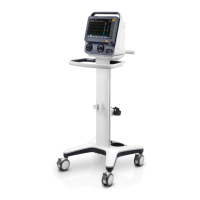
Do you have a question about the Mindray SV300 and is the answer not in the manual?
| Waveform Display | Pressure, Flow, Volume |
|---|---|
| Battery Backup | Up to 2 hours |
| Ventilation Modes | VCV, PCV, SIMV |
| Tidal Volume Range | 20 to 2000 mL |
| FiO2 | 21 to 100% |
| Inspiratory Time | 0.2-5.0 s |
| Monitoring Parameters | Paw, Ppeak, Pmean, Pplat, PEEP, VTI, VTE, MV, f, FiO2, I:E |
| Alarms | High/Low Airway Pressure, High/Low Minute Volume, High/Low Tidal Volume, High/Low Respiratory Rate, High/Low FiO2, Apnea, Power Failure |
| Power Supply | AC 100-240V, 50/60Hz |
| Peak Flow | 180 L/min |
| Trigger Sensitivity (Flow) | 0.5-10 L/min |
Details hazard symbols (DANGER, WARNING, CAUTION, NOTE) and associated safety guidelines.
Step-by-step guide on mounting the main unit onto the ventilator trolley.
Instructions for connecting the ventilator to AC and DC power sources.
Details procedures for connecting high-pressure and low-pressure O2 supplies.
Instructions for connecting patient tubing, filters, water traps, and HME.
Details the main interface elements: display, alarm light, control knob, and function keys.
Steps to power on the ventilator and initiate the startup sequence.
Procedure and requirements for running essential system checks before patient use.
Guides on selecting previous patient data or entering new patient details for ventilation.
Explains the differences between invasive and non-invasive ventilation and how to set.
Overview of available ventilation modes and how to set their parameters.
Procedure to initiate ventilation after all settings are confirmed.
Explains the principle of CO2 monitoring using infrared light absorption.
Guides on setup, settings, and limitations for sidestream CO2 measurement.
Instructions for connecting, setting up, and using the mainstream CO2 module.
Explains SpO2 monitoring principle, components, and displayed values.
Highlights critical safety warnings related to SpO2 sensor use and compatibility.
Step-by-step guide for correctly attaching the SpO2 sensor to the patient.
Details how to set SpO2 monitoring, sensitivity, beat volume, and sweep speed.
Automatically adjusts gas delivery pressure based on ET or Trach tube type and diameter.
Method for increasing O2 concentration via simple tube connections or masks.
Explains how alarms are indicated and the system's self-detection of alarm functions.
Classifies alarms into physiological, technical, and prompt messages.
Describes the preset high, medium, and low priority levels for alarms.
Details visual and audible signals used for alarm notification.
Instructions for adjusting the volume of audible alarms.
Configures alarm limits for parameters like Paw, MV, FiO2, and Tapnea.
Procedures to verify the functionality of various alarm conditions.
General procedure for handling alarms, including checking the patient and condition.
Details recommended cleaning and disinfection methods for various ventilator parts.
Instructions for disassembling components like expiration valve, safety valve, and filters.
Outlines policy for repairs, emphasizing authorized service and component replacement.
Lists recommended maintenance tasks and frequencies for parts and the entire ventilator.
Steps to zero pressure and flow sensors when readings deviate significantly.
Guidelines and procedures for performing electrical safety tests on the equipment.
Details settable and internal alarm parameters, including ranges and conditions.
Lists physiological alarms, their causes, and recommended troubleshooting actions.
Lists technical alarms, their causes, and recommended troubleshooting actions.